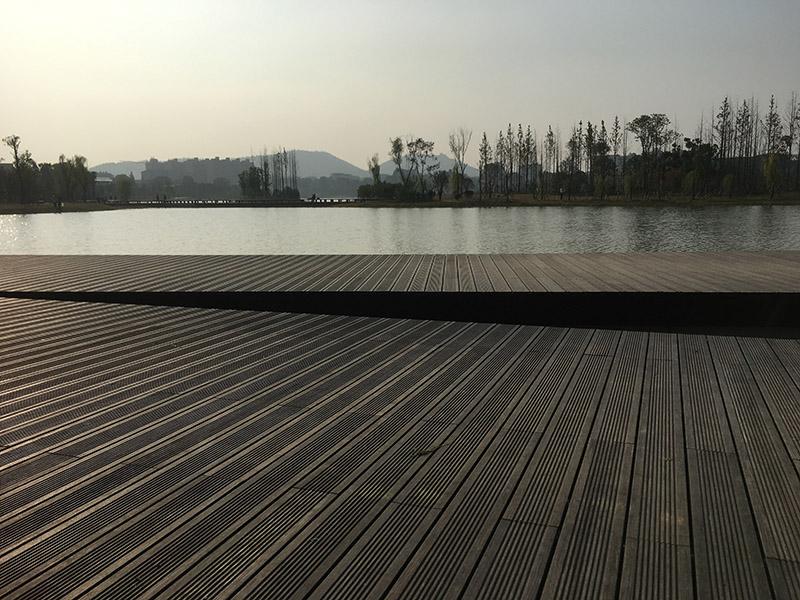When building or upgrading a patio, choosing the right decking material is more than a matter of looks. Durability, resistance to moisture, maintenance requirements, and environmental impact all factor into the decision. For years, traditional hardwoods like teak, ipe, and redwood have dominated outdoor spaces. But engineered bamboo decking is quickly becoming a serious contender—and for good reason.
As a decking factory technologist, I’ve worked with both materials extensively. While hardwood has a long legacy, bamboo offers unique advantages that are often overlooked. To understand which material is best suited for your patio, it’s worth comparing how each is harvested, manufactured, and protected—starting from the source.
Harvesting: Trees vs. Grass
Traditional wood decking is typically sourced from slow-growing hardwood trees. Depending on the species, these trees can take 30 to 100 years to reach maturity. Once cut, reforestation takes decades, and unsustainable logging can lead to long-term environmental damage.
Bamboo, on the other hand, isn’t a tree—it’s a giant grass. The species used for decking, typically Phyllostachys edulis (Moso bamboo), reaches maturity in just 5 to 6 years. After harvesting, the root system remains intact, allowing the plant to regrow without replanting. This rapid renewability gives bamboo a major edge in terms of sustainability.
But not all bamboo is grown the same way. High-quality decking starts with responsibly harvested, mature bamboo. Younger culms have high sugar content and lower density, making them more prone to rot and insect damage. Mature bamboo, harvested at peak age, forms the foundation for durable strand-woven decking.
Manufacturing: Milling vs. Engineering
Hardwood decking is typically sawn into boards, kiln-dried, and sanded. While it's a relatively straightforward process, the performance of the final product depends heavily on the inherent characteristics of the species—density, grain, and natural oil content.
Bamboo decking undergoes a more engineered transformation. After harvesting, the bamboo is split into strips, boiled to remove starches, and dried. From there, the real work begins:
Strand-woven bamboo is produced by shredding the fibers, combining them with adhesives, and compressing them under heat and pressure into dense, uniform planks.
This process increases the density of the material to over 1,100 kg/m³, far higher than most hardwoods.
The boards are then milled into decking profiles, sanded, and coated with a penetrating waterproof oil for outdoor protection.
The result is a product that’s less dependent on the natural irregularities of wood and more consistent in strength, stability, and appearance.
Density and Stability: The Heavyweight Advantage
One of the most critical factors in outdoor decking is dimensional stability—how well a material resists swelling, warping, and cracking due to moisture and temperature changes.
Traditional hardwoods vary widely in density. While species like ipe and cumaru are extremely dense and durable, others like cedar and redwood are much softer and more porous, requiring frequent sealing and maintenance.
Strand-woven bamboo’s engineered density gives it a leg up. With compression rates pushing it into the high-performance category, it offers:
Superior hardness (comparable or higher than ipe)
Low expansion and contraction rates
Minimal cupping or warping with proper installation
This high density also makes it more resistant to surface damage, such as dents or scratches from furniture or foot traffic.
Quality Control: Precision Matters
With traditional wood, quality varies by tree, region, and even the part of the tree used. Inconsistent grain patterns, knots, and internal stress can lead to performance issues over time.
Bamboo decking is engineered in a controlled environment, allowing for strict quality control measures at every stage:
Moisture content is closely monitored before pressing to prevent shrinkage or swelling.
Adhesive distribution is calibrated to ensure long-lasting bonds between fibers.
Pressing temperature and pressure are standardized for uniform density.
Dimensional checks are performed to ensure each board meets tolerance specifications.
These factory-level controls result in a more predictable product with fewer surprises after installation.
Waterproof Oil: The First Line of Defense
Outdoor decking needs protection from the elements. Most hardwoods rely on their natural oils to resist water and decay, but even ipe and teak benefit from regular sealing.
Bamboo decking comes pre-treated with high-performance waterproof oil, designed to penetrate deep into the fibers. This oil not only repels moisture but also:
Prevents mold and mildew growth
Protects against UV degradation
Enhances the natural color and grain of the bamboo
Unlike surface coatings that peel over time, penetrating oils wear gradually and can be easily reapplied without sanding. Maintenance is straightforward—clean, oil, and repeat every 1–2 years depending on exposure.
A Side-by-Side Snapshot
Feature Traditional Wood Bamboo Decking
Harvest Time 30–100 years 5–6 years
Sustainability Depends on species/source Highly renewable
Density Varies by species ~1,100 kg/m³ (strand-woven)
Stability Moderate to high Very high
Mold Resistance Species-dependent Engineered + treated
Maintenance Regular sealing required Periodic oiling
Appearance Natural grain, warm tones Uniform, modern look
Which One Should You Choose?
If you're looking for a sustainable, dense, and weather-resistant decking material that performs consistently and looks great, strand-woven bamboo is a strong candidate. Its engineered properties offer advantages in moisture resistance, structural stability, and ease of maintenance.
Traditional hardwood still has its place, particularly for those who prefer a more rustic or natural aesthetic, and are willing to invest the time and effort into maintenance. But for patios that face sun, rain, and high traffic, bamboo decking offers a compelling, modern solution grounded in smart material science and responsible manufacturing.



